| Pages:
1
..
42
43
44
45
46
..
68 |
markx
National Hazard
   
Posts: 645
Registered: 7-8-2003
Location: Northern kingdom
Member Is Offline
Mood: Very Jolly
|
|
As an alternative to extracting PIB from selfvulcanizing tape (very expensive option) one can use rodent glues as a fair source of PIB too (cheap
option).
E.g: http://www.kollant.it/Rat-poison/Glues.aspx
I just tried the Norat version and it works like a charm for plastisizing PETN. The glue is a fairly low polymerisation grade PIB that is a viscous
liquid and can be used without the need for an additional plastisizer. With 15-20% content one ends up with a very decent plastique that only has 2
components.
Exact science is a figment of imagination.......
|
|
|
Laboratory of Liptakov
International Hazard
    
Posts: 1339
Registered: 2-9-2014
Location: Technion Haifa
Member Is Offline
Mood: cool.gif
|
|
dimethicone
Next interestling compound is polydymethylsiloxan, name for commerce is dimethicone. Only 2% contets doing from sand plastic material. Video: https://www.youtube.com/watch?v=50_-zqsgDA4
Here is can buy. http://domaci-kosmetika.eu/244-silikon-dimethicone.html
Oxygen balance on CO2 is - 172,5 sumar C2H6OSi next in wiki
[Edited on 5-7-2015 by Laboratory of Liptakov]
|
|
|
Hennig Brand
International Hazard
    
Posts: 1284
Registered: 7-6-2009
Member Is Offline
Mood: No Mood
|
|
EFP Powered by 87% ETN Putty Explosive Initiated by EBW, ETN, Detonator - Success
After watching the video where an EFP was tested with only a thin plastic casing and what was estimated to be a liner thickness of only 2-3% of its
diameter I decided to try reducing the thickness of my liners. A piece of 3/4" grade L copper plumbing pipe is almost exactly the right thickness
(0.03" or 0.76mm) to give a liner thickness of 3% of the diameter used (24mm). The test worked beautifully, even at a standoff of only 16" the slug
narrowed and elongated and easily penetrated the 3/8" steel target. I should try a 1/2" target next.
The charge was 12.2g of 87% ETN / 13% PB. The casing was a thin polypropylene disposable pill bottle. The cap holder was made from the pill bottle top
liner/seal. The cap used was an exploding bridgewire type, with copper bridgewire, one of three which were made about a month ago. Details of how I
have been constructing them are in the thread, "Has anyone made a EBW Setup". The only explosive in the caps is ETN. The 0.5uF capacitor bank was
charged to about 3800V before firing. The firing line used was 50ft of RG-6 coaxial cable and another 5ft or so of 18 gauge speaker wire added to the
ends as sacrificial cable.
The liner was made from a piece of 3/4", L grade copper plumbing pipe as already mentioned. A short piece of the pipe was cut lengthwise with a hack
saw and pried and hammered flat into a sheet. A blank was cut out with a homemade cutter and hydraulic press and then annealed and shaped into a dish
with a dapping block and ball bearing punch. The thickness of the liner was about 0.03" or about 0.76mm or about 3% of the liners diameter. The depth
of curvature of the dish was about 4mm or about 16.7% of its diameter.
Reducing the thickness of the liner from 5% to 3% of its diameter made all the difference, at least with this setup with a very weak, thin plastic,
casing. I am fairly sure 1/2" of steel could have easily been penetrated which would be about 0.5D, as it is 3/8" of penetration is about 0.4D which
is still respectable.
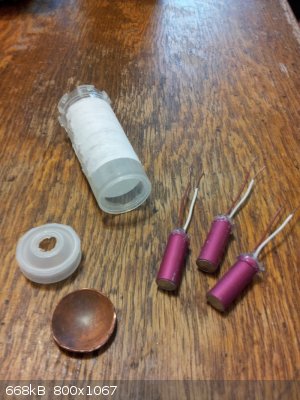 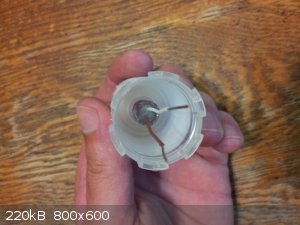 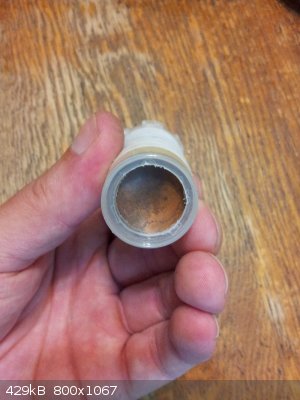 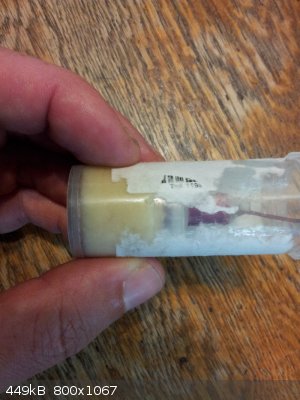 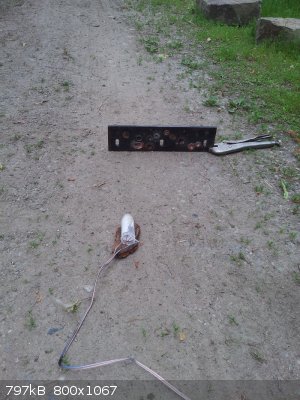 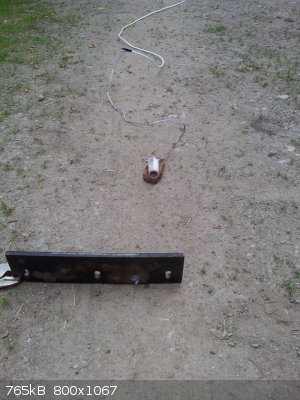 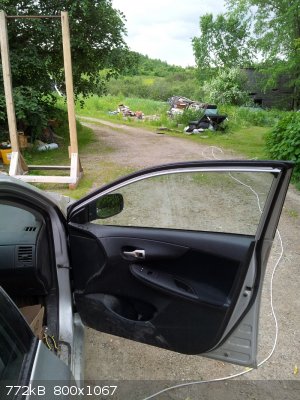 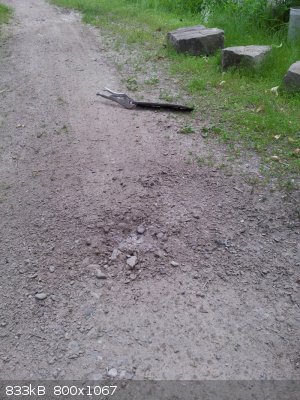 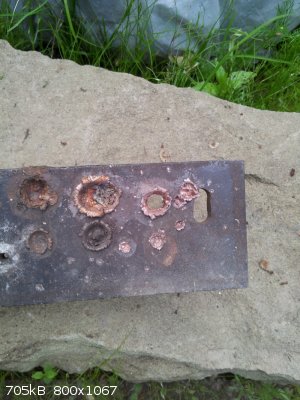 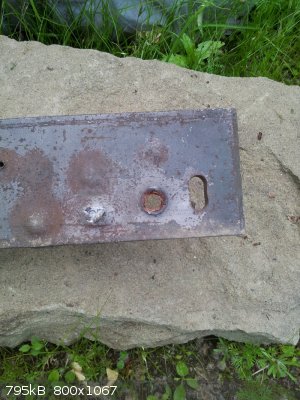 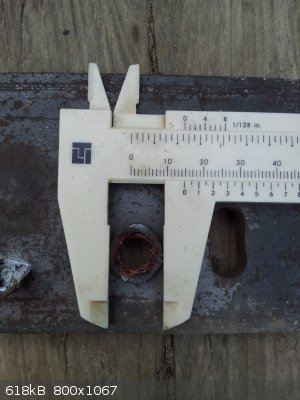
Polydimethylsiloxane is the most important member of the silicone oils. I have a couple of small bottles and I sometimes add a bit to PIB or PB bound
plastic explosives as a plasticizer/softener, but most of the time I have just been using mineral oil and lately just pure PB without any added
softener.
[Edited on 6-7-2015 by Hennig Brand]
"A risk-free world is a very dull world, one from which we are apt to learn little of consequence." -Geerat Vermeij
|
|
|
nux vomica
Hazard to Others
  
Posts: 267
Registered: 18-7-2013
Member Is Offline
Mood: No Mood
|
|
Nice result Henning looks like all the pieces of the puzzle are coming together, I dont think that plate would take much more abuse looks a shotgun
has blasted it 
[Edited on 6-7-2015 by nux vomica]
|
|
|
Hennig Brand
International Hazard
    
Posts: 1284
Registered: 7-6-2009
Member Is Offline
Mood: No Mood
|
|
Thanks, yeah, that is the first EFP that really worked properly for me, as in the slug narrowed and elongated significantly and gave decent
penetration. There was a little splatter, but the bulk of the copper seemed to go through the main hole. Yeah, the pieces are coming together I think.
I know that annealed copper is much easier to work with, but I wonder how important it is that the copper liner be well annealed prior to firing.
I just noticed that I didn't put a link to where the EBW detonator construction was discussed. Here is a link:
http://www.sciencemadness.org/talk/viewthread.php?tid=23466&...
[Edited on 6-7-2015 by Hennig Brand]
"A risk-free world is a very dull world, one from which we are apt to learn little of consequence." -Geerat Vermeij
|
|
|
nux vomica
Hazard to Others
  
Posts: 267
Registered: 18-7-2013
Member Is Offline
Mood: No Mood
|
|
The copper liners I have been useing were formed from annealed sheet but I didn't anneal them after forming them.
|
|
|
Laboratory of Liptakov
International Hazard
    
Posts: 1339
Registered: 2-9-2014
Location: Technion Haifa
Member Is Offline
Mood: cool.gif
|
|
Perfectly Henning! Finally, clean the hole. As I say, the packaging is not essential. Annealing is important. It's a little challenging process. 1
minute under the P-B flame. The red glow. A slow cool down in the open air. The most important thing is accuracy. The next destination will be 1/2
inch? Hmmm. = 12.7 mm. That's a lot of rough armor. Liptakov :-)
|
|
|
greenlight
National Hazard
   
Posts: 705
Registered: 3-11-2014
Member Is Offline
Mood: Energetic
|
|
That is a very good result Henning, so effective for only 12 grams HE.
I think I am going to reconsider my charge specs as I can penetrate just over 1/4 inch steel but I am using 30 grams PETN to your 12 grams for same
result but my impact isn't as clean.
I think I will try using plastic next time as well as it seems to get better results.
|
|
|
Hennig Brand
International Hazard
    
Posts: 1284
Registered: 7-6-2009
Member Is Offline
Mood: No Mood
|
|
Thanks, things are starting to come together.
I may not be doing a perfect job of annealing, but the copper seems to get very soft by simply heating it up red for a few seconds with a propane
torch and letting it cool.
Theoretically the added inert material(s) do lower explosive performance, but sensitivity is much less so safety is much higher, high density,
uniformity and ease of loading are all major advantages of plastic explosives as well. It can be much harder to properly load loose powdered high
explosive.
Quote: Originally posted by markx  | As an alternative to extracting PIB from selfvulcanizing tape (very expensive option) one can use rodent glues as a fair source of PIB too (cheap
option).
E.g: http://www.kollant.it/Rat-poison/Glues.aspx
I just tried the Norat version and it works like a charm for plastisizing PETN. The glue is a fairly low polymerisation grade PIB that is a viscous
liquid and can be used without the need for an additional plastisizer. With 15-20% content one ends up with a very decent plastique that only has 2
components. |
I have been using this bird repellent product. Picked up the 4.5lb pail a few years ago for $40-50. Works well at 87% ETN / 13% bird repellent (high
%PB) and makes a product very similar to Semtex in handling properties from the descriptions I have read and videos I have seen.
http://www.nixalite.com/tanglefoot.aspx
[Edited on 6-7-2015 by Hennig Brand]
"A risk-free world is a very dull world, one from which we are apt to learn little of consequence." -Geerat Vermeij
|
|
|
Laboratory of Liptakov
International Hazard
    
Posts: 1339
Registered: 2-9-2014
Location: Technion Haifa
Member Is Offline
Mood: cool.gif
|
|
plasticizer
Well, very important informations of plasticizers. And it is important for quality homogeneity EM in EFP. Thanks. Rat or bird, everybody will be in
EFP. Liptakov
|
|
|
Hennig Brand
International Hazard
    
Posts: 1284
Registered: 7-6-2009
Member Is Offline
Mood: No Mood
|
|
I should have added this above, but I lost my chance.
I just measured the density of the 87% ETN / 13% PB plastic explosive and it is about 1.40-1.42g/cc, which is slightly lower but still very close to
the density of the 80/10/10, ETN/PB/mineral oil plastique.
"A risk-free world is a very dull world, one from which we are apt to learn little of consequence." -Geerat Vermeij
|
|
|
greenlight
National Hazard
   
Posts: 705
Registered: 3-11-2014
Member Is Offline
Mood: Energetic
|
|
Hennig, do you or anyone else have a tried and true method for recrystallization of PETN or ETN into crystal sizes perfect for plasticizing.
Should I just dissolve in acetone and slowly evaporate over a number of days.
|
|
|
Hennig Brand
International Hazard
    
Posts: 1284
Registered: 7-6-2009
Member Is Offline
Mood: No Mood
|
|
I haven't put a lot of energy into controlling ETN crystal size and shape. I recrystallize ETN from methanol allowing the solution to cool naturally
with no added insulation and once cool water is added to precipitate more as a finer powder. The product is chemically very pure with relatively small
crystal size. Much larger crystals can be grown if desired. Perfection is hard/impossible to achieve, but yeah I could be putting more energy into
controlling this variable which would likely yield benefits in terms of density and possibly improved handling properties, etc. In short, I don't know
a great deal about what is optimum at this point.
"A risk-free world is a very dull world, one from which we are apt to learn little of consequence." -Geerat Vermeij
|
|
|
greenlight
National Hazard
   
Posts: 705
Registered: 3-11-2014
Member Is Offline
Mood: Energetic
|
|
I have heard that crystals that resemble fine sand are good for plasticizing.
I think I will try your method but substitute the methanol for acetone. Do you bring the methanol to near boiling, dissolve as much as possible and
cool on its own. Then when cool add enough water to precipitate the rest of product? Does this sound correct?
|
|
|
Hennig Brand
International Hazard
    
Posts: 1284
Registered: 7-6-2009
Member Is Offline
Mood: No Mood
|
|
Look for posts by Nitro-Genes, he did quite a lot of experimenting with crystallization techniques, etc, for plastic explosive production (mostly PETN
I think).
Once you have dissolved as much as you can it is best to add a little more solvent (i.e. 10-20% excess or so) so that as it starts to cool the
precipitation is not immediate and not extremely rapid (prevent avalanche precipitation for better purity). For safety, use a pre-heated hot water
bath as heat source to bring the methanol to near boiling.
EFP Liner Thickness
I don't know how I could have missed this, in fact I don't think I did I think I was simply trusting that earlier patent which suggested that the
liner thickness should be between 5 and 10% of the diameter. I doubt that patent considered devices this small however. I also didn't fully
appreciate earlier how significant liner thickness was as a variable. The mini RISI EFP has a liner thickness of only about 2.7% of its diameter. I
posted this before, but it is only a tiny file so I will post it again here for convenience.
Attachment: Mini EBW Initiated EFP.pdf (29kB)
This file has been downloaded 466 times
[Edited on 8-7-2015 by Hennig Brand]
"A risk-free world is a very dull world, one from which we are apt to learn little of consequence." -Geerat Vermeij
|
|
|
nitro-genes
International Hazard
    
Posts: 1048
Registered: 5-4-2005
Member Is Offline
|
|
A very interesting way of possibly making spherical ETN (PERFORM REMOTE though!!!) that I thought of:
What would happen if you would add recrystallized ETN to a beaker in water, add a stirrerbar and put it on a waterbath of about 80 deg C (just enough
to melt the ETN while in water). After putting it in the waterbath you can leave the stirring go on remotely and slowly the ETN will start to melt.
Due to the water surrounding and stirring, the ETN will likely form small spherical globules (stirring RPM and stirrer bar will determine size), that
upon slowly cooling down of the waterbath may be retained as such. This operation wouldn't need any supervision and can be performed remotely. Maybe
an emulsifier could help also.  Anyway, just an idea worth trying... Anyway, just an idea worth trying...
Nice results btw Henning with the last EFP, clean entrance and good penetration! Regarding the after annealing of the liner: for conical shaped
charges it has been shown that spun formed liners introduce spin to the jet due to retaining stresses when unannealed. For a shaped charge this would
likely be detrimental, unless the SC is used in barrel fired HEAT rounds, where it can counterbalance barrel rotation. My guess would be that, unlike
the delicate jet from an SC, an EFP might not be so sensitive to induced spin, maybe even enhancing long range accuray due to gyroscopic stability.
Might be interesting to look at spun formed EFP liners. Other approaches for spin stabilized EFP's are introducing fins. I've seen some simple designs
in patents that consist of a thick copper plate forming the main liner, with sort of a "cross" pattern of thin coppersheet soldered onto the plate
before forming the liner. These thicker liner parts move more slowly compared to the main liner and will form protruding fins for stability.
Also would be really cool if something like a pile of wood, sawdust, rockwool or ballistic gel could be used to retrieve the EFP without to much
deformation. 
Regarding crystallization, it is difficult to get PETN to recrystallize into equidimensional crystal shapes easiliy, therefore I used to blender small
amounts in water to abrass the crystalls into rounded shapes that can make very high density plastiques. I didn't like this process from a safety
standpoint and was only performed with small amounts and remote operation. THIS IS NOT ADVISABLE WITH ETN THOUGH!!!!
Depending on whether you want high density, high critical diameter plastique or a lower density, low critical diameter plastique I would a different
approach.
High density: Slow crystallization from ethanol (best solvent for crystallization IMO) by cooling in the freezer, than adding icecold water at one to
precipitate the remaining ETN as a very fine crystal fraction to fill the voids in the plastique. Than add a liqour of binder+plasticizer in
heptane/hexane and keep rolling and needing until fully dried. After prolonged rolling and kneeding to abrass the crystals, it will probably make a
good plastique with about 10-12% inerts.
Low density, low critical diameter: Make a fully saturated solution of ETN in ethanol/methanol and slowly poor this into ice cold water with rapid
stirring. This will form a very fine amorphous crystal fraction that needs 15-20% inerts, but can detonate in very thin sheets.
[Edited on 7-7-2015 by nitro-genes]
|
|
|
greenlight
National Hazard
   
Posts: 705
Registered: 3-11-2014
Member Is Offline
Mood: Energetic
|
|
Thanks Hennig and Nitro genes for that information, it will help a lot.
|
|
|
NeonPulse
Hazard to Others
  
Posts: 417
Registered: 29-6-2013
Location: The other end of the internet.
Member Is Offline
Mood: Isolated from Reality! For Real this time....
|
|
Quote: Originally posted by greenlight  | I have heard that crystals that resemble fine sand are good for plasticizing.
I think I will try your method but substitute the methanol for acetone. Do you bring the methanol to near boiling, dissolve as much as possible and
cool on its own. Then when cool add enough water to precipitate the rest of product? Does this sound correct?
|
In one experiment i preformed a Very slow evaporation of the acetone over days from a PETN solution. It resulted in very long flat crystals that were
very clear. quite pure but due to their size they werent able to be used for any practical application. Ethyl acetate used in the same manner gave
very short thick and dense crystals similar to a quartz garden. they were also impractical for use. Toluene is said to give cubic crystals but im yet
to try this.
I cant recall in which thread i saw this but Rosco Bodine outlined a very good recrystallization method in which a solution of acetone and PETN is
made with a small amount of bicarb and urea and under good stirring to the hot solution a cube of ice is added to begin seeding allowing it to melt
before adding another piece, and perodically more ice is added like this. next very slowly iced water is dropped in a drop at a time over a period of
time depending on the amount of acetone. you can get a nice fine gritty sand like crop of crystals that are relatively even and free flowing as well
as having a good density as opposed to just crashing the mixture into water. This method has worked well for me in the past nd the result was worth
the time it took to do. You should look into it. Very interesting method. if you ask Rosco he may remember where he posted it. I think it was in the
PETN vs RDX thread.
|
|
|
Rosco Bodine
Banned
Posts: 6370
Registered: 29-9-2004
Member Is Offline
Mood: analytical
|
|
Yes I remember
http://www.sciencemadness.org/talk/viewthread.php?tid=6151&a...
|
|
|
greenlight
National Hazard
   
Posts: 705
Registered: 3-11-2014
Member Is Offline
Mood: Energetic
|
|
Thanks Rosco and NP, that looks like a nice method to try next time that should result in some high quality crystals.
For now I have just dissolved in near boiling acetone, added a 20% excess solvent, cooled and poured very slowly into an equal volume of cold water
which has resulted in nice fine crystals. I will plasticize these and see how it goes in EFP.
|
|
|
Hennig Brand
International Hazard
    
Posts: 1284
Registered: 7-6-2009
Member Is Offline
Mood: No Mood
|
|
EFP Powered by 87% ETN Putty Explosive Initiated by EBW, ETN, Detonator - Success Again
This test was performed in exactly the same way as the last, except that the target was 1/2" of steel instead of 3/8". I noticed that the standoff may
have actually been a little under 16" the last time but this time it was carefully set at 16".
Quote: Originally posted by Hennig Brand  |
The charge was 12.2g of 87% ETN / 13% PB. The casing was a thin polypropylene disposable pill bottle. The cap holder was made from the pill bottle top
liner/seal. The cap used was an exploding bridgewire type, with copper bridgewire, one of three which were made about a month ago. Details of how I
have been constructing them are in the thread, "Has anyone made a EBW Setup". The only explosive in the caps is ETN. The 0.5uF capacitor bank was
charged to about 3800V before firing. The firing line used was 50ft of RG-6 coaxial cable and another 5ft or so of 18 gauge speaker wire added to the
ends as sacrificial cable.
The 24mm diameter liner was made from a piece of 3/4", L grade copper plumbing pipe. A short piece of the pipe was cut lengthwise with a hack saw and
pried and hammered flat into a sheet. A blank was cut out with a homemade cutter and hydraulic press and then annealed and shaped into a dish with a
dapping block and ball bearing punch. The thickness of the liner was about 0.03" or about 0.76mm or about 3% of the liners diameter. The depth of
curvature of the dish was about 4mm or about 16.7% of its diameter.
|
The copper projectile made a nice clean hole through the target. The best piece of steel I could find in the scrap pile was tapered, but careful
aiming allowed me to hit it right where its thickness was slightly over 1/2". All the nice even pieces of plate I could turn up yesterday in the scrap
pile seemed to be 7/16" for some reason. I think I need to try a 5/8" target next, since it looked like the projectile possible could have done more.
Of course now that I have the formula right EFP technology no longer seems finicky at all.
BTW, a good targeting laser is nice especially for long range targeting, but a low tech method that works really well at close ranges like these is to
simply use a straight piece of wood such as a straight meter stick. The EFP can be easily aimed/lined up with the target by holding the straight edge
along the EFP casing side and also top.
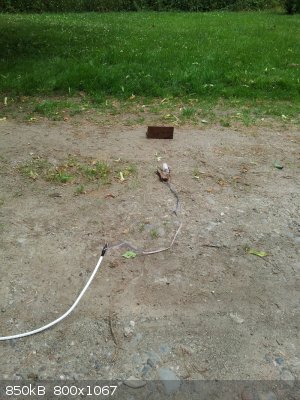 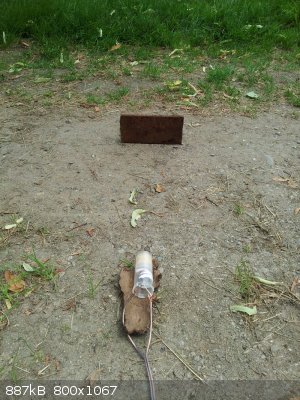 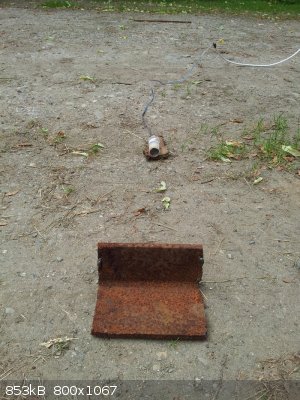 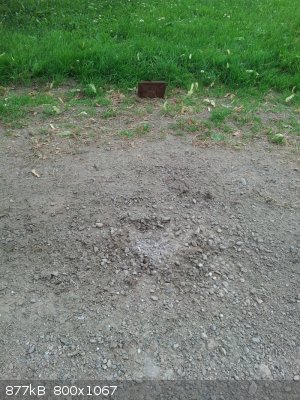 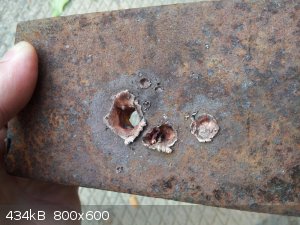 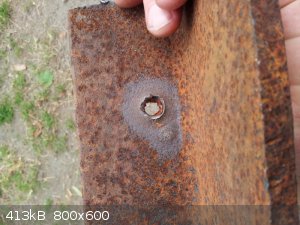 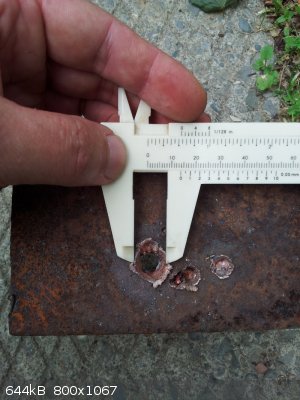 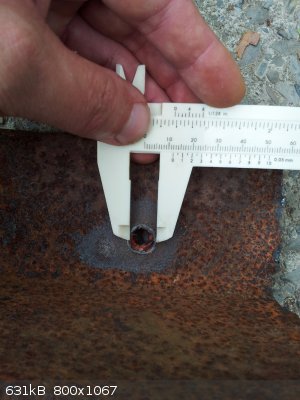 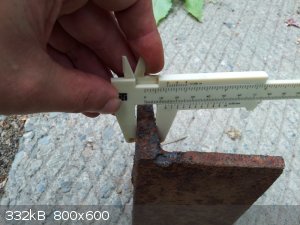
[Edited on 11-7-2015 by Hennig Brand]
"A risk-free world is a very dull world, one from which we are apt to learn little of consequence." -Geerat Vermeij
|
|
|
nux vomica
Hazard to Others
  
Posts: 267
Registered: 18-7-2013
Member Is Offline
Mood: No Mood
|
|
Nice one hennig what are the outher 2 hits , too far away and moveing closer?
|
|
|
greenlight
National Hazard
   
Posts: 705
Registered: 3-11-2014
Member Is Offline
Mood: Energetic
|
|
Outstanding effect on target again with such a small amount of explosive and halfway to penetrating a full inch of steel.
[Edited on 12-7-2015 by greenlight]
|
|
|
Hennig Brand
International Hazard
    
Posts: 1284
Registered: 7-6-2009
Member Is Offline
Mood: No Mood
|
|
Thanks. This is the first shot since the one described earlier on this page of this thread, the other shallow holes are the result of a bit of liner
breakup again I guess. The bulk of the liner seems to have stayed together and gone through the main hole though. The amount of penetration is much
more limited with EFPs than with Munroe effect SCs but they can be used at much greater standoff, the exact standoff used is not nearly as critical
and the hole made is normally much larger in diameter. This last test produced over 0.5D of penetration (1/2"). Penetrating 5/8" would be well over
0.6D of penetration.
[Edited on 12-7-2015 by Hennig Brand]
"A risk-free world is a very dull world, one from which we are apt to learn little of consequence." -Geerat Vermeij
|
|
|
nux vomica
Hazard to Others
  
Posts: 267
Registered: 18-7-2013
Member Is Offline
Mood: No Mood
|
|
Quote: Originally posted by Hennig Brand  | Thanks. This is the first shot since the one described earlier on this page of this thread, the other shallow holes are the result of a bit of liner
breakup again I guess. The bulk of the liner seems to have stayed together and gone through the main hole though. The amount of penetration is much
more limited with EFPs than with Munroe effect SCs but they can be used at much greater standoff, the exact standoff used is not nearly as critical
and the hole made is normally much larger in diameter. This last test produced over 0.5D of penetration (1/2"). Penetrating 5/8" would be well over
0.6D of penetration.
[Edited on 12-7-2015 by Hennig Brand] |
Haha you nearly got 3 for the price of one there.
I wonder why the liner broke up like that , it would have been interesting to see what it would do if it stayed together.
Maybe the liner is slightly too thin and is being over formed.
[Edited on 12-7-2015 by nux vomica]
|
|
|
| Pages:
1
..
42
43
44
45
46
..
68 |